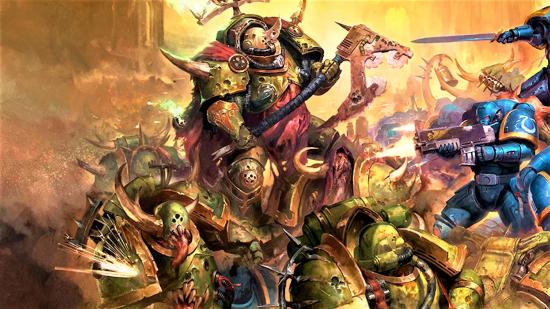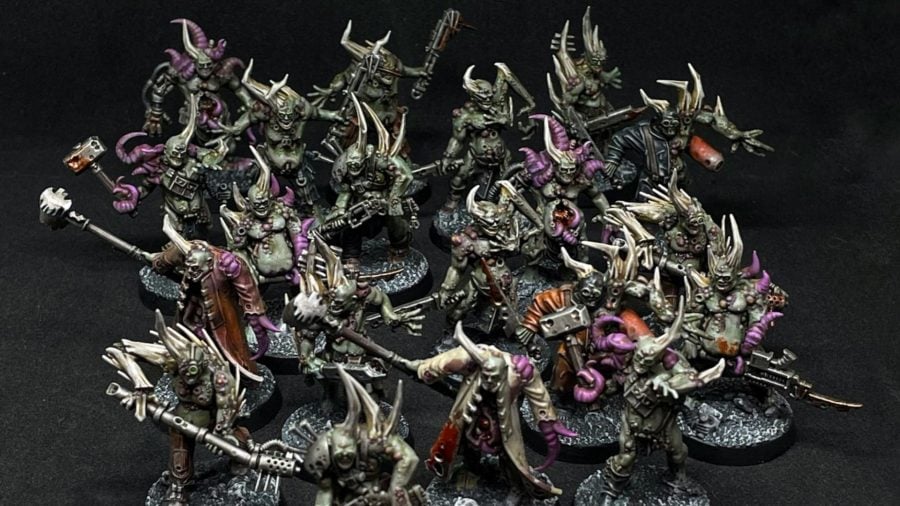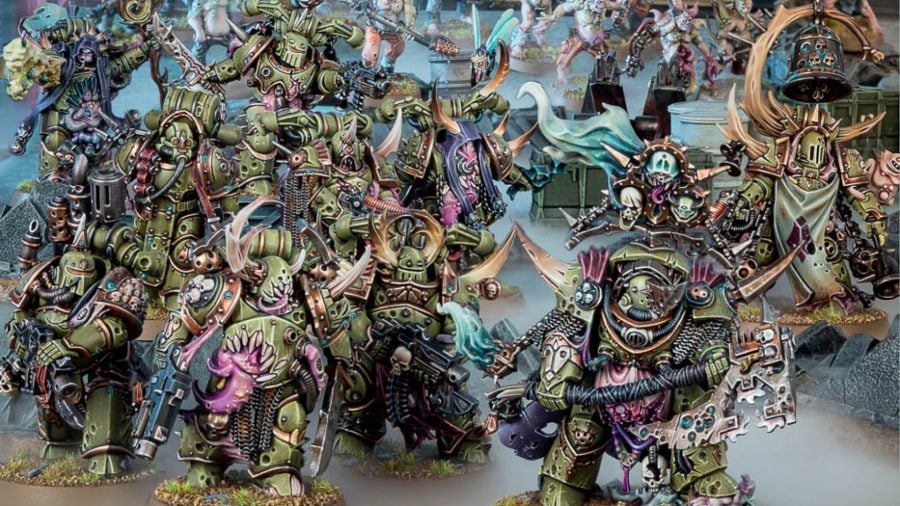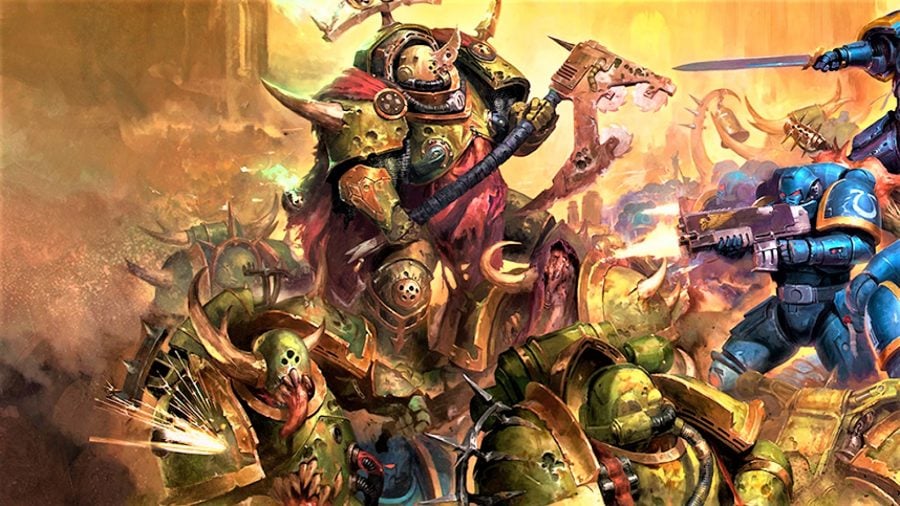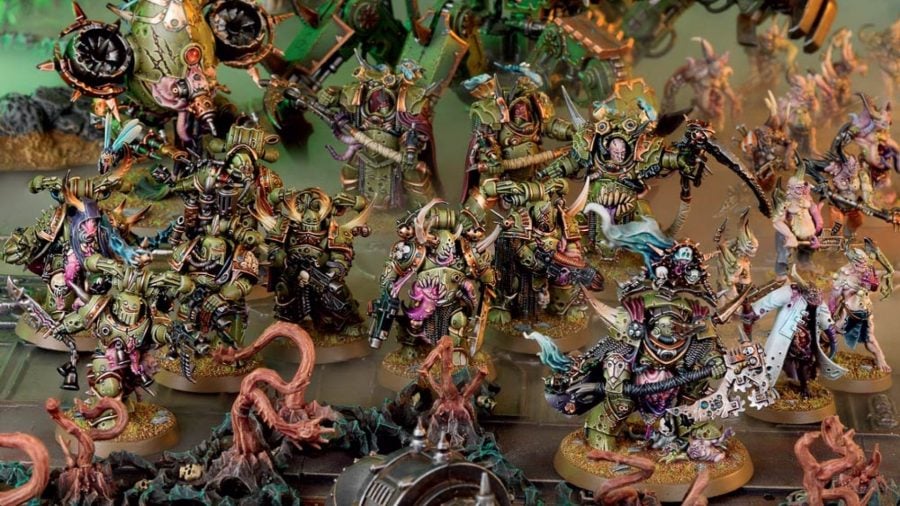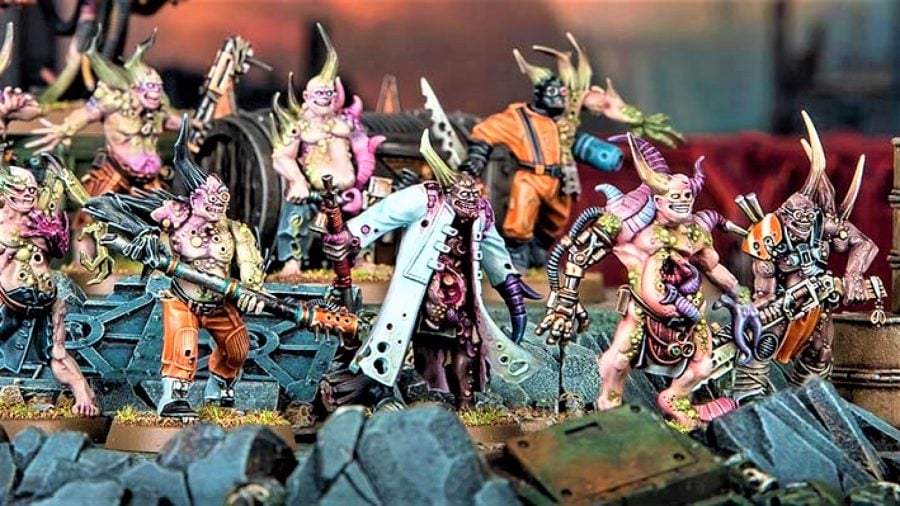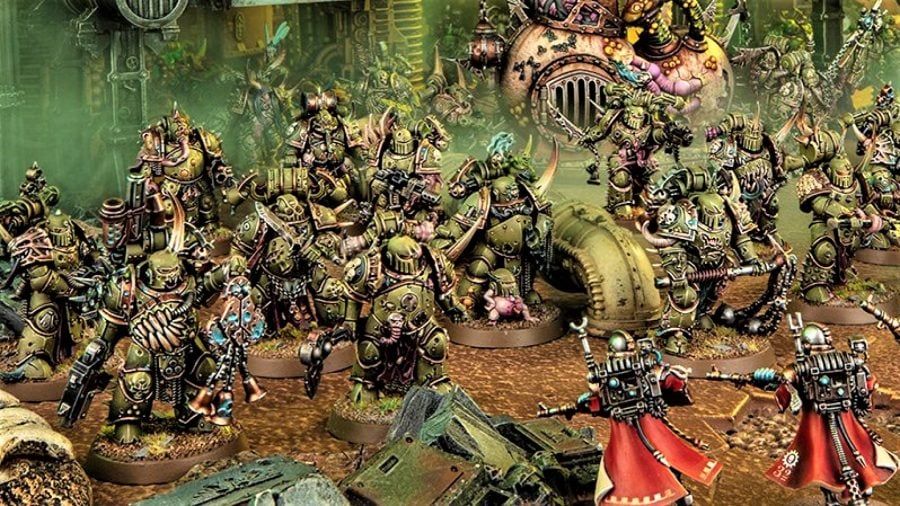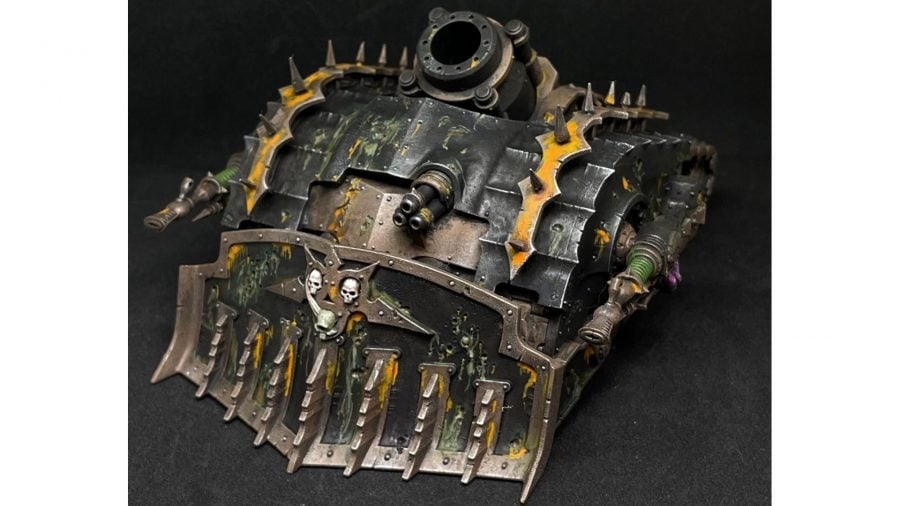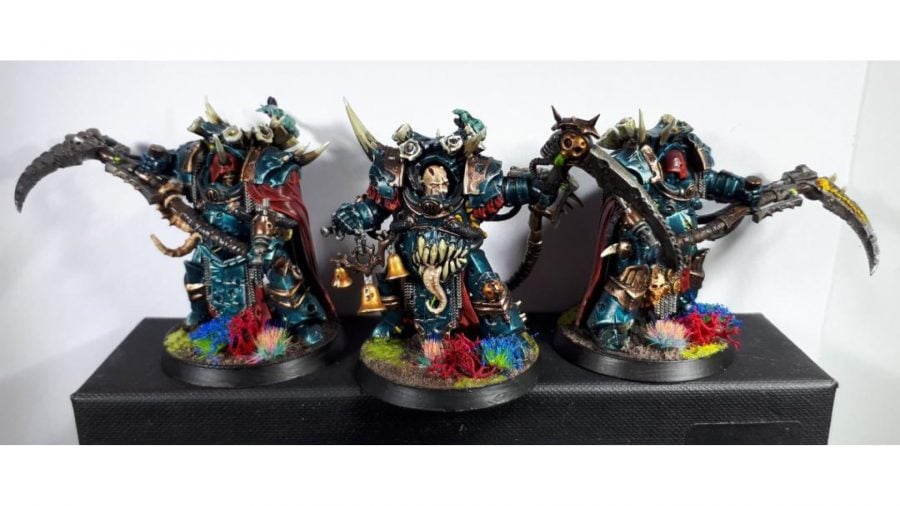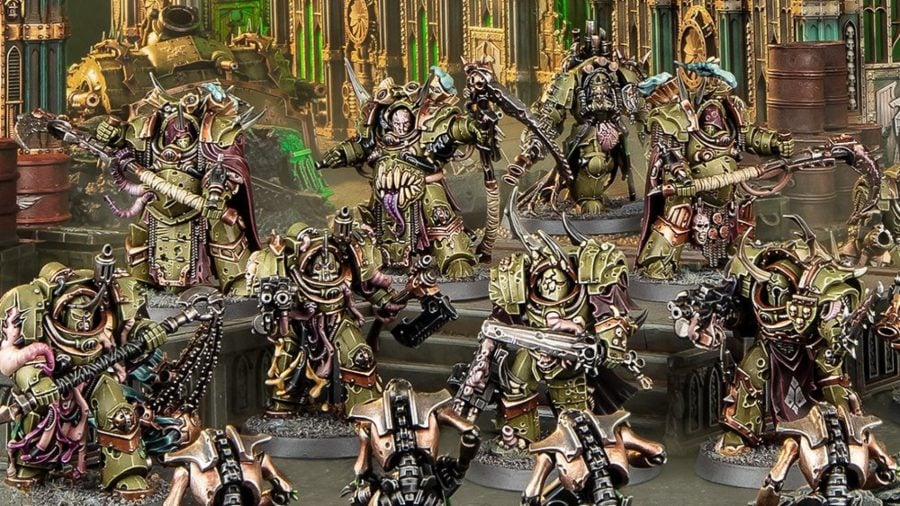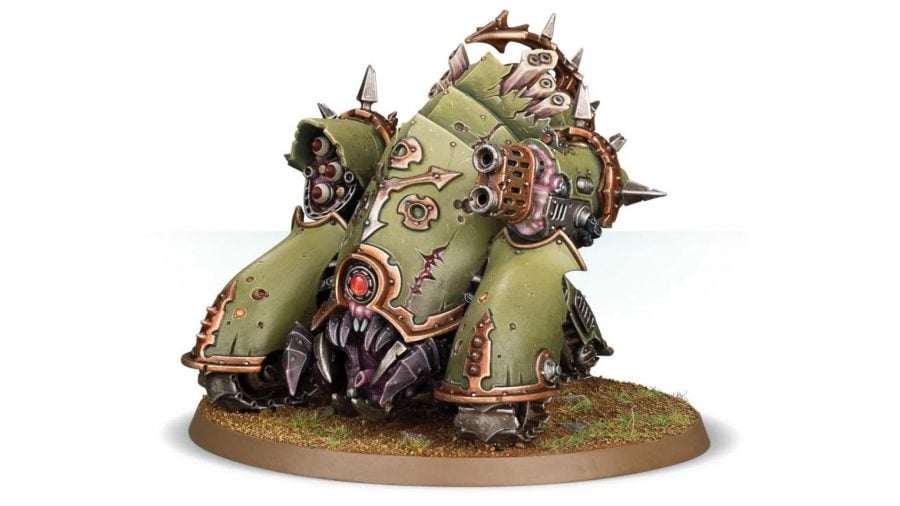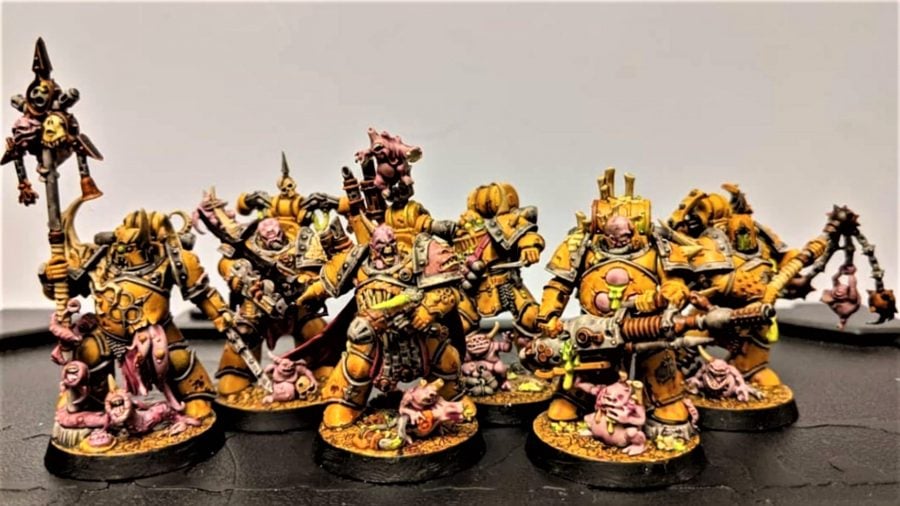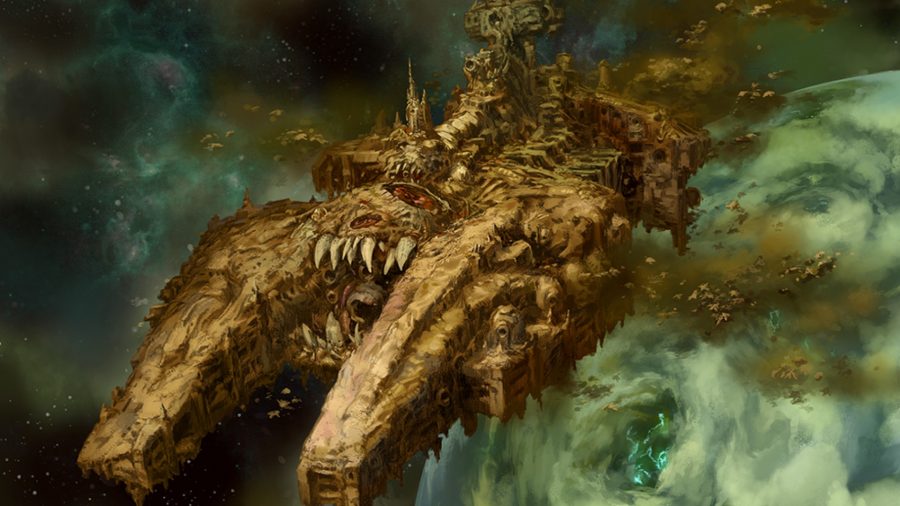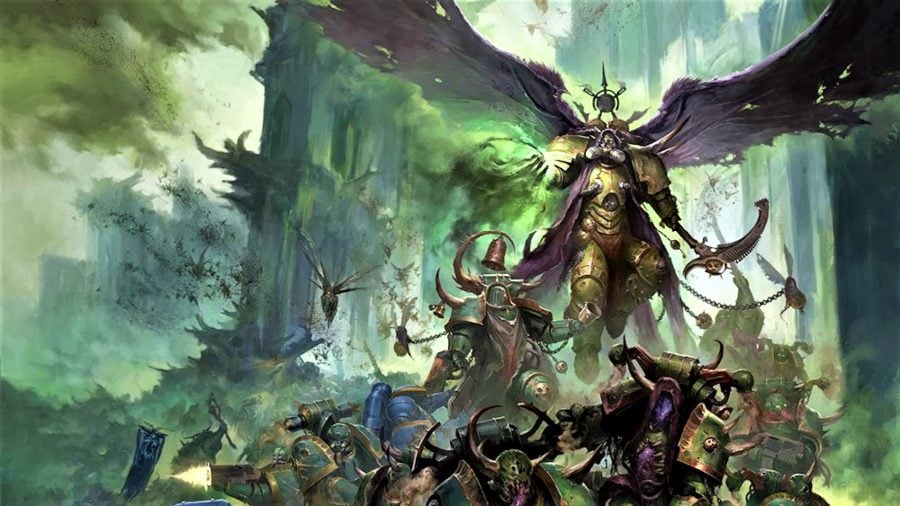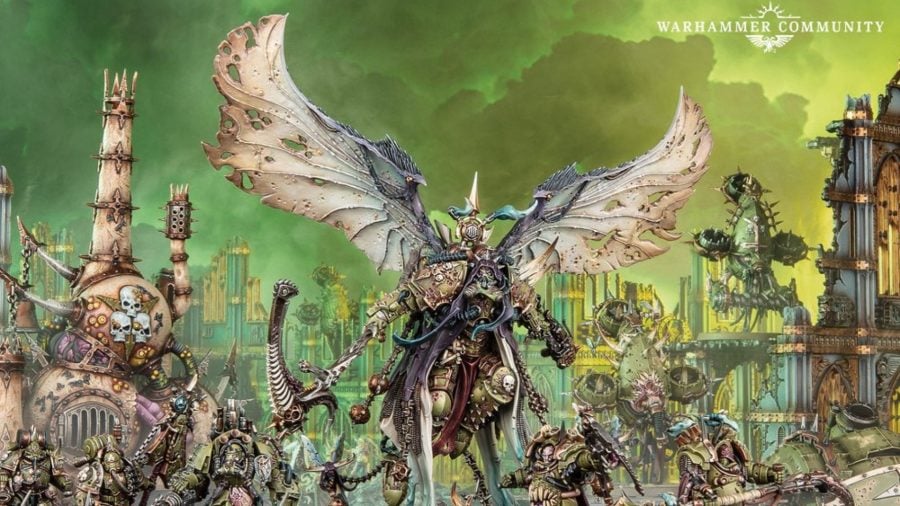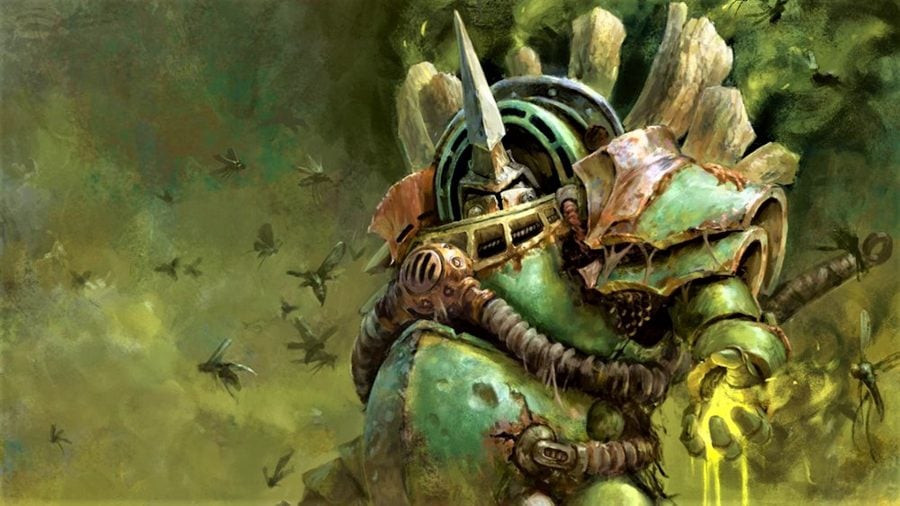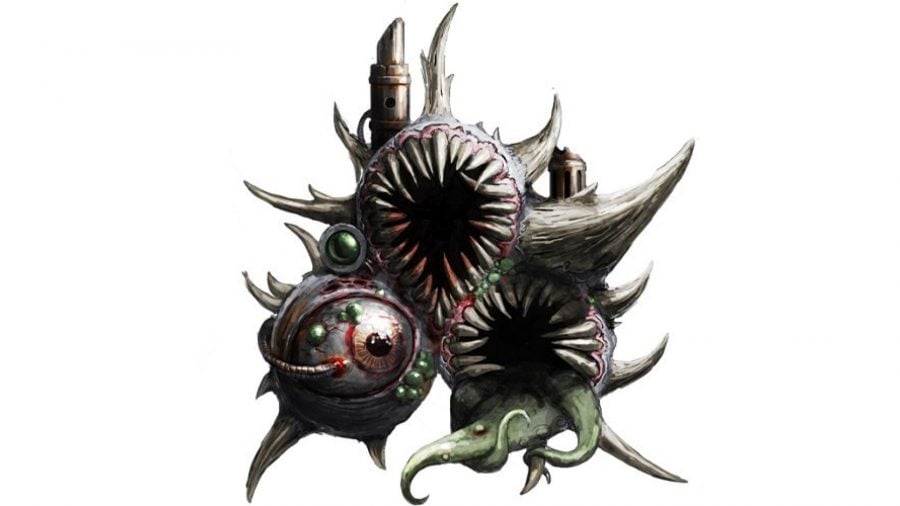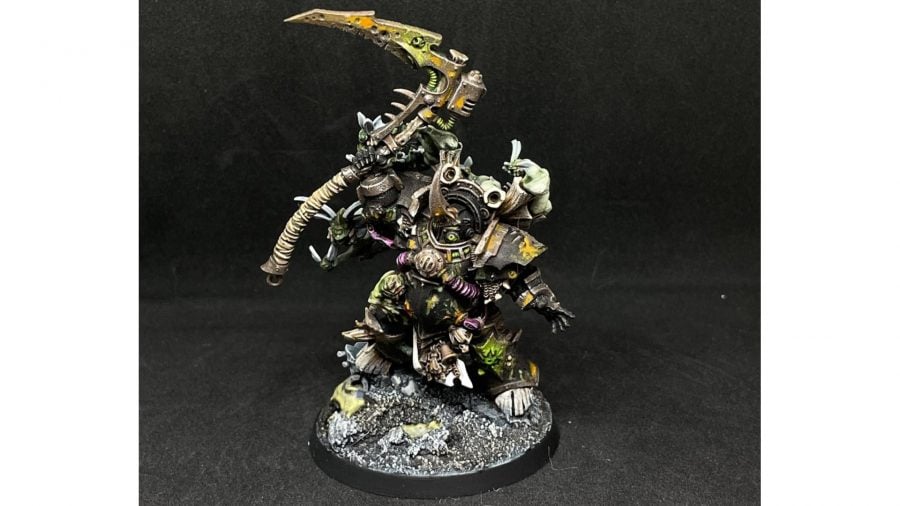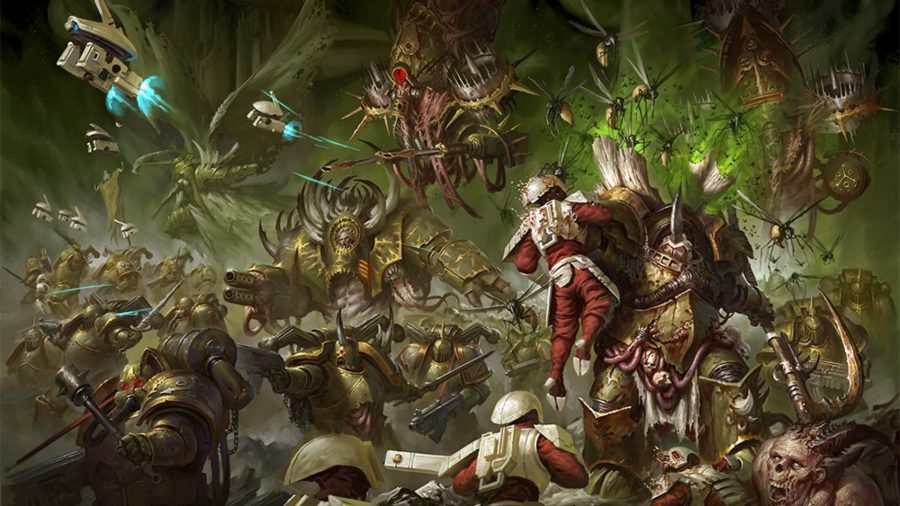Of all Warhammer 40k’s Chaos armies, the Death Guard are the very foulest. Cursed by an ancient pact with the plague god Nurgle, each one of them is impossibly afflicted by supernatural illness and insane mutation.
Warhammer 40k’s Death Guard army features a diverse roster of revolting Chaos Space Marine warriors, making for a varied (if vomitous) array of tabletop possibilities. Read on for our guide to the Death Guard’s lore, tactics, and rules – and how you can dive into the filth yourself.
The Death Guard are walking vectors of every infection imaginable, so diseased they should not be able to live, much less wage war in the name of their hideous patron – yet still they fight. In fact, paradoxically, their ailments lend them vigour, making them hardier than even the Primaris Space Marines. And, far from resenting their plague-bearing plight, they rejoice in the sickness, and revel in spreading their feculent patron’s gifts to an unwilling galaxy.
Shambling, once-human Poxwalkers crowd forwards ahead of the main force, their mouths twisted into rictus grins, their bodies deformed by peculiar mutations. Behind them, rumbling vehicles grind through the putrefying soil. Some of them are ancient Predator and Land Raider tanks, now pocked with corrosion and afflicted with fleshy growths, relics of a war they’ve waged for 10,000 years.
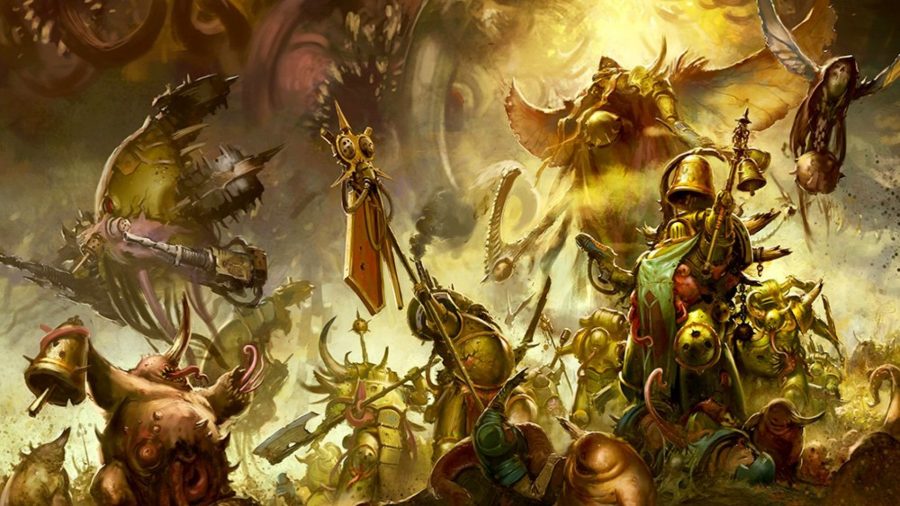
Others, such as the slug-like Plagueburst Crawlers and rabid, triple-tracked Myphitic Blighthaulers, are so-called ‘daemon engines’ – the souls of malevolent warp beings shackled into a physical machine.
And, among this cavalcade of madness, the Chaos Space Marines of the Death Guard march stolidly forwards, plague-ridden bodies impervious to the puny weaponry flung against them by terrified defenders.
The Death Guard are the rust-encrusted gauntlet of the plague god Nurgle. If you want an army that laughs in the face of enemy fire and spreads corruption as readily as it does death, look no further.
Here’s what you need to know about the Death Guard:
- Warhammer 40k 10th edition Death Guard rules
- Death Guard melee combat
- Death Guard Combat Patrol
- Death Guard lore
- Mortarion, Daemon Primarch of the Death Guard
- Typhus, Herald of Nurgle
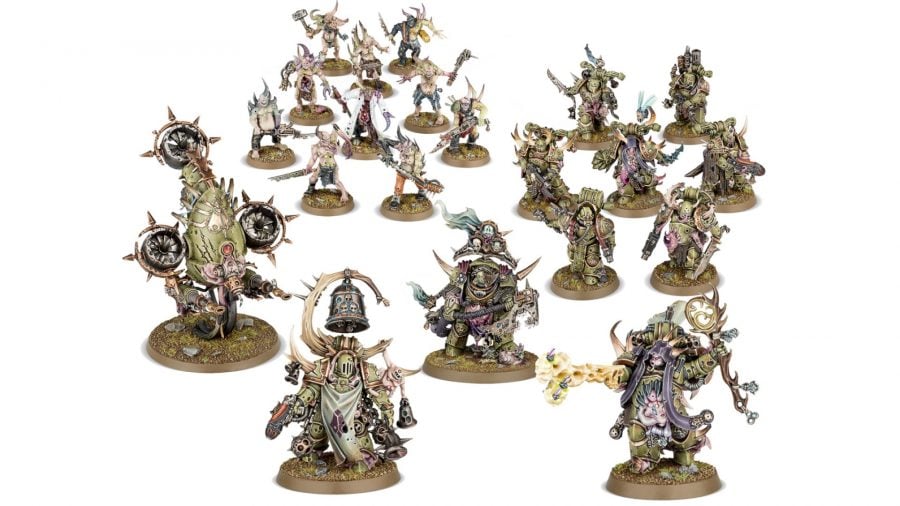
Warhammer 40k 10th edition Death Guard rules
This article explains the main information from the Warhammer 40k 10th edition Death Guard rules that you’ll need to bear in mind when planning your army.
Click here to download your free Death Guard 10th edition Index cards PDF.
Winning with the Death Guard requires bringing your considerable short-range power to bear efficiently. You’ve got to remove the threats that can push through your endurance, claim objectives intelligently to mitigate your own lack of manoeuvrability, and position your forces carefully to mitigate the superior long-range firepower of your enemies.
Slow and purposeful
Not every unit in the Death Guard is slow, but none of them are really fast. Myphitic Blighthaulers and Foetid Bloat Drones have a 10” move, which is about as good as it gets.
Plague Marines have a plethora of powerful short range weaponry and deadly melee plague weapons, but they lack any means to Charge after Advancing, and rely on the humble Rhino or bullet-magnet Land Raider for transport.
This is core to the Death Guard’s identity, and you’ll have to embrace it. You don’t have the manoeuvrability to chase nimble enemies, so you need to work out ways to bring them to battle on your own terms, teleporting Terminators into position to restrict enemy lines of retreat, or projecting overwhelming force onto an objective. When you do bring it all to bear on the enemy, the results can be devastating.
Disgustingly resilient
In eighth and ninth edition 40k the Death Guard had an ability called Disgustingly Resilient which provided them with additional survivability. That’s not the case in 10th edition.
As befits the scions of Grandfather Nurgle, the corpulent bodies of the Death Guard are incredibly hard to destroy. Their bog-standard Plague Marines have Toughness 5 and two wounds, as tough as an Ork and as die-hard as a Space Marine.
The Death Guard’s notorious Blightlord Terminators are even harder to shift: with a 4+ invulnerable save, three wounds apiece, and Toughness Six. Deathshroud Terminators, the prized bodyguard of Mortarion who now serve in many Death Guard Warbands as his silent watchers, have the ‘Silent Bodyguard’ ability; when an attack hits their unit while they are led by a character, if the Strength of the attack is greater than their Toughness, the attacker suffers -1 to Wound.
Death Guard bring other defensive abilities to the field, too. Daemon engines like the Myphitic Blight-Hauler and Foetid Bloat-Drone have a 5+ invulnerable save. The stratagem Cloud of Flies is a potent defensive buff: for 1CP it grants one of your units the Stealth core ability during your opponents’ shooting phase, inflicting a -1 to hit penalty.
The Plague Surgeon, though in the narrative more concerned with curating new strains of disease than healing anyone, can return a destroyed bodyguard model to the unit he’s joined during the Command Phase with his Tainted Narthecium. He’s also able to join a unit with another character, and his ‘Diseased Healing’ allows him to return up to three lost wounds to a wounded character within 3″.
Though they often have to wade through barrages of enemy fire, the Death Guard have the fortitude to survive it, and close to killing range with the enemy.
Death Guard Aura of Contagion and Nurgle’s Gift
Every Death Guard model projects an aura of contagion around itself. This starts 3″ wide in battle-round one, and grows by 3″ each battle-round, capping out at 9″. Enemies within contagion range suffer from Nurgle’s Gift, suffering a -1 penalty to their toughness.
As you would expect from the Plague God’s favoured servants, Mortarion’s sons are absolutely riven with disease. They augment their conventional offensive potential with deadly viruses, radioactive toxins, or other chemical reagents.
Plague Marines, the foetid backbone of the Death Guard, are armed with Plague Boltguns and Plague knives as standard, and can swap them out for Bubotic Weapons. This unhealthy coating is represented in the game by the Lethal Hits weapon ability, which turns critical hits – normally natural rolls of six – into automatic wounds.
Many Death Guard are equipped with weapons that spray out gouts of deadly toxin, like the Plague Sprayer or Plague Belcher. These all have the Torrent, Ignores Cover, and Anti-Infantry 2+ abilities, making them lethal infantry clearance tools
Death Guard melee combat
Death Guard pack a heavyweight punch at medium to close range. The Foul Blightspawn’s Plague Sprayer is especially noteworthy: it’s a hideously powerful flamethrower of daemonic pus, with D6 Strength 7, AP -2, Damage 2 attacks that automatically hit, and wounds infantry on 2+. Mortarion’s silent bodyguards, the Deathshroud Terminators, wield smaller versions called Plaguespurt gauntlets, alongside their vicious Manreaper scythes.
Since their first incarnation in The Lost and the Damned, the Death Guard have carried Blight Grenades – shrunken heads filled with the plague God’s foulest gifts.
All Plague Marines in power armour have the Grenades keyword, giving them access to the Core Stratagem of the same name. The Biologus Putrifier is absolutely strapped with exotic and esoteric explosives, and can use the Grenades stratagem for free once per turn.
To free up your elite infantry to close with the enemy, use cheap troops (like Poxwalkers and Cultists) and ranged vehicles (like Plagueburst Crawlers and Predators) which can sit on objectives and lend their firepower across the board.
Death Guard Combat patrol
The Death Guard Combat Patrol box contains a tide of 30 poxwalkers, seven plague marines, a Biologus Putrifier, and the dreaded Typhus. This is a solid start to any force: Typhus is a terrifying Warlord who combines psychic might, combat prowess, and a buff for Poxwalkers into a single, filthy package.
Though Typhus can join a unit of Poxwalkers, you might want to put him in a unit of Terminators to benefit from Deep Strike. While Deathshroud are holy terrors in melee, your force already suffers from a lack of ranged weaponry, so you’re probably better off with Blightlord Terminators. These are excellent, bringing respectable melee capabilities, some ranged punch, and extremely durable bodies.
If you want to build a conventional Death Guard force from here, and play with all of their toys, take a Plagueburst Crawler and a Myphitic Blighthauler daemon engines.
Both will add anti-tank firepower; the Crawler is slow, durable, carries a huge plague mortar that can target units out of line of sight, and has the option for sponson-mounted Entropy cannons, while the Blighthauler is fast, comparatively fragile, and happiest when it follows up a salvo of missiles and melta-fire by charging into enemy lines.
If you want to follow The Traveller and his terrifying teleport troops, a second Patrol box is the cheapest way to create a zombie horde and add to your troops, and you’ll be able to eBay your second Typhus and Biologus Putrifier.
Death Guard lore
The Death Guard were the XIVth Legion Astartes, one of twenty forged by the Emperor to spearhead the Great Crusade that would claim the galaxy in the name of humankind.
Recruiting from the toxic world Barbarus, the Death Guard prided themselves on their hardiness, their indomitability, and their resistance to pain. They fought in the foulest of warzones, prosecuting the most uncompromising and gruelling sieges through swamps poisoned by industrial waste, trenches filled with radioactive contaminants, or jungles alive with alien plagues.
They often deployed deadly and proscribed weaponry from the Dark Age of Technology, including viral bombs, radiation missiles, and crawling phosphex.
As the Horus Heresy approached, however, curdled pride turned the legion away from the Imperial cause, and towards darker ends. Captain Calas Typhon seeded secretive lodges within the legion, creating a secret society that was more loyal to the legion than to the Imperium, while the Primarch Mortarion nursed his own old grudges against the Emperor. Mortarion was among the first to declare his fealty for Horus when the Warmaster dragged the Imperium into civil war.
By the end of that devastating conflict, the Death Guard had fallen into the service of a more terrible master indeed. Nurgle, Plaguefather, Grandfather of Decay, Chaos god of plagues and foetid rebirth, delighted in the Death Guard’s stoicism and endurance, and transformed them into his vessels of contagion.
Now the Death Guard stalk the stars, superhuman monsters made even more impossibly resilient and hideously deadly by the interference of the warp.
In 10,000 years since the Heresy, the Death Guard have struck out from their bases within the Eye of Terror to spread Nurgle’s blessings across the Imperium. Mortarion, now a Daemon Primarch of Nurgle, fights his brother Roboute Guilliman across the worlds of Ultramar, turning paradise planets into heaving mires of sludge and decay.
First Captain Typhon is now called Typhus, Herald of Nurgle, and he has set his sights on the Charadon sub-sector, determined to reveal the hubris of Forgeworld Metallica, whose Tech-Adepts believe their blessed machines are immune to Nurgle’s supernatural infections.
Mortarion, Daemon Primarch of the Death Guard
Every champion of the Death Guard is a monster beyond the worst nightmares of mortals, terrifying death bringers that have sickened star systems and turned worlds to rot. But two among them cast shadows that are particularly long, and as dark as a gangrenous wound: the legion’s haunted genefather Mortarion, and his scheming First Captain, now called Typhus.
We have a complete guide to Mortarion if you have the stomach to discover the roots of his vile heresy. Suffice to say, by the time he led his Death Guard in the Siege of Terra, Mortarion had been fully embraced by the Plague God Nurgle, and transformed into the vast, bug-winged, daemonic form he now takes.
A terrifying, towering entity as large as an Imperial Knight, he still wields the arms and armour with which he fought during the Great Crusade – the xenos pistol Lantern and the mighty scythe Silence, clad in the Barbaran Plate – though they have been imbued with terrifying warp-power, as befits his status among the most exalted Daemon Princes of Nurgle.
On the tabletop, Mortarion is a true centrepiece model, both in size and in-game impact. As the undisputed master of the Death Guard and Nurgle’s affections, he is a ‘Host of Plagues’, granting him the choice of three different Aura abilities each Battle Round:
- ‘Miasma of Pestilence’ grants the benefit of cover to Death Guard within 6″
- ‘Diseased Influence’ allows Death guard within 6″ to re-roll wound rolls of one
- ‘Toxic presence’ increases by 3″ the contagion range of Death Guard within 12″; we’ll explain contagion range later.
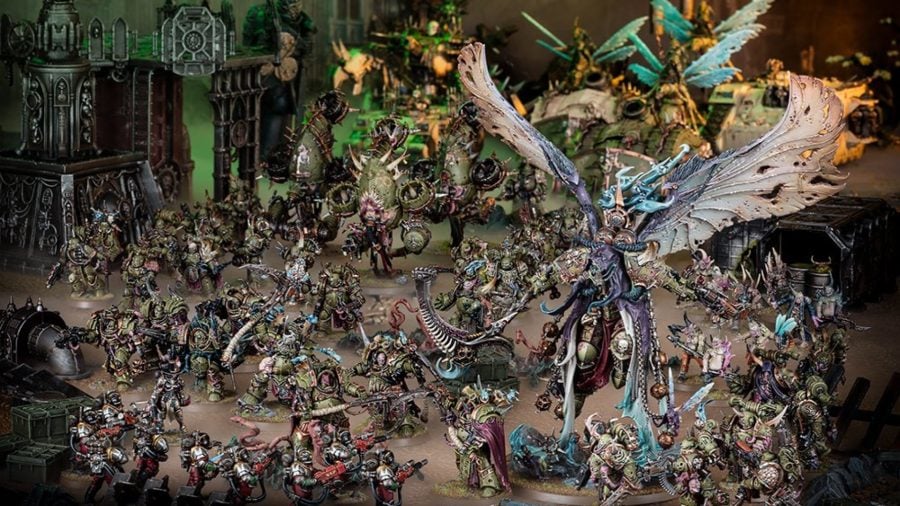
Wielding a scythe the size of a dreadnought, he has the melee capability you would expect, while Feel No Pain 5+ and a 4+ invulnerable save from the Barbaran Plate, together with the Toughness and Wounds of a Land Raider make him very durable.
Mortarion will be target number one for your opponent, but, if he has the chance to get to grips with the foe, he will tear that heart from the enemy with a single, diseased claw.
Typhus, Herald of Nurgle
Typhus, the Traveller, Herald of Nurgle, Host of the Destroyer Hive, master of the dead who walk… Typhus has many names, each one earned through uncountable atrocities enacted in the name of the plague God.
The Barbaran youth Calas Typhon kept a secret: he was gifted with psychic abilities, not unlike those of the alien masters that ruled the planet Barbarus.
When he completed the trials that saw him uplifted into the ranks of the Astartes, he quickly learnt that his close friend Mortarion despised any hint of witchcraft, associating such things with his despised adopted father. Typhon suppressed his powers, turning his focus instead to mastering the martial discipline and fortitude that were the pride of the legion.
Typhon quickly rose through the ranks, earning a reputation for prowess and endurance that saw him elevated to the position of First Captain. But, after serving in a campaign alongside the Word Bearers legion, who had already been subverted to the secretive worship of Chaos, Typhon learnt of a different path – and of different masters who might look upon his psychic gift more favourably. Typhon founded the Sevenfold Lodge within the legion, a secretive organisation that became the seed of rebellion.
As the Heresy ground on, Typhon was drawn deeper under the sway of Nurgle. Mortarion was determined to spearhead the Warmaster’s assault upon Terra, but Typhon convinced him that the fleet’s navigators were agents of the Emperor, executing them all. Typhon then offered to use his gifts to guide the Death Guard fleet through the warp. Reluctantly, Mortarion accepted.
The Death Guard were quickly marooned within the warp, afflicted by supernatural sicknesses beyond the ability of even the Death Guard to resist. Their bodies bloated, putrefied, mutated, corrupted, running with pus and ichor, rot and gangrene, yet somehow incapable of dying.
The Destroyer Plague and Nurgle’s Rot ravaged them, driving warriors insane and rotting the very souls of the Astartes. Eventually Mortarion, most stoic and indomitable of the Primarchs, succumbed to the only path he could see that would end his sons’ suffering: he pledged them all, body and soul, to Nurgle.
Typhon was richly rewarded. The billions of boiling flies that infested the fleet swarmed into his body, hollowing him and filling him with the indescribable sickness of the Destroyer Plague. Now Typhon was Typhus, host of the Destroyer Hive, a walking vessel for Nurgle’s sickness.
Since the failure of the Heresy, Typhus has followed his own path. Mortarion’s stronghold within the Eye of Terror disgusts him as sentimental, for Mortarion has sculpted the Plague Planet in mimicry of lost Barbarus.
For his part, Mortarion is content to let his wayward son roam, spreading Nurgle’s gifts across an unwilling cosmos. Sometimes they make war together, when the cause will aid Nurgle’s plans – such as when Typhus supported Mortarion’s conflict in the Ultramar Segmentum.
Often, though, Typhus strikes out alone, or else lends his forces to Abaddon the Despoiler, of the Black Legion; Typhus was instrumental in spreading plagues before the 13th Black Crusade – the war that destroyed Cadia and rent the Imperium in two by opening the Cicatrix Maledictum.
On the tabletop, Typhus is a powerful character, combining psychic might and the formidable melee prowess of his Master-Crafted Manreaper. ‘The Destroyer’ Hive penalises enemies that target him or his bodyguard unit with -1 to hit. ‘The Eater Plague’ is a deadly psychic ability that on a 2+ inflicts D6 mortal wounds on an enemy unit, increasing to D3+3 on a roll of 6.
With thanks to Ash Curtis for his noxious yellow Plague Marines, Helterskelter for his sinister dark jade Deathshroud and Alexander Lachwitz for his black metal Typhus, Plagueburst Crawler, and Poxwalkers.
